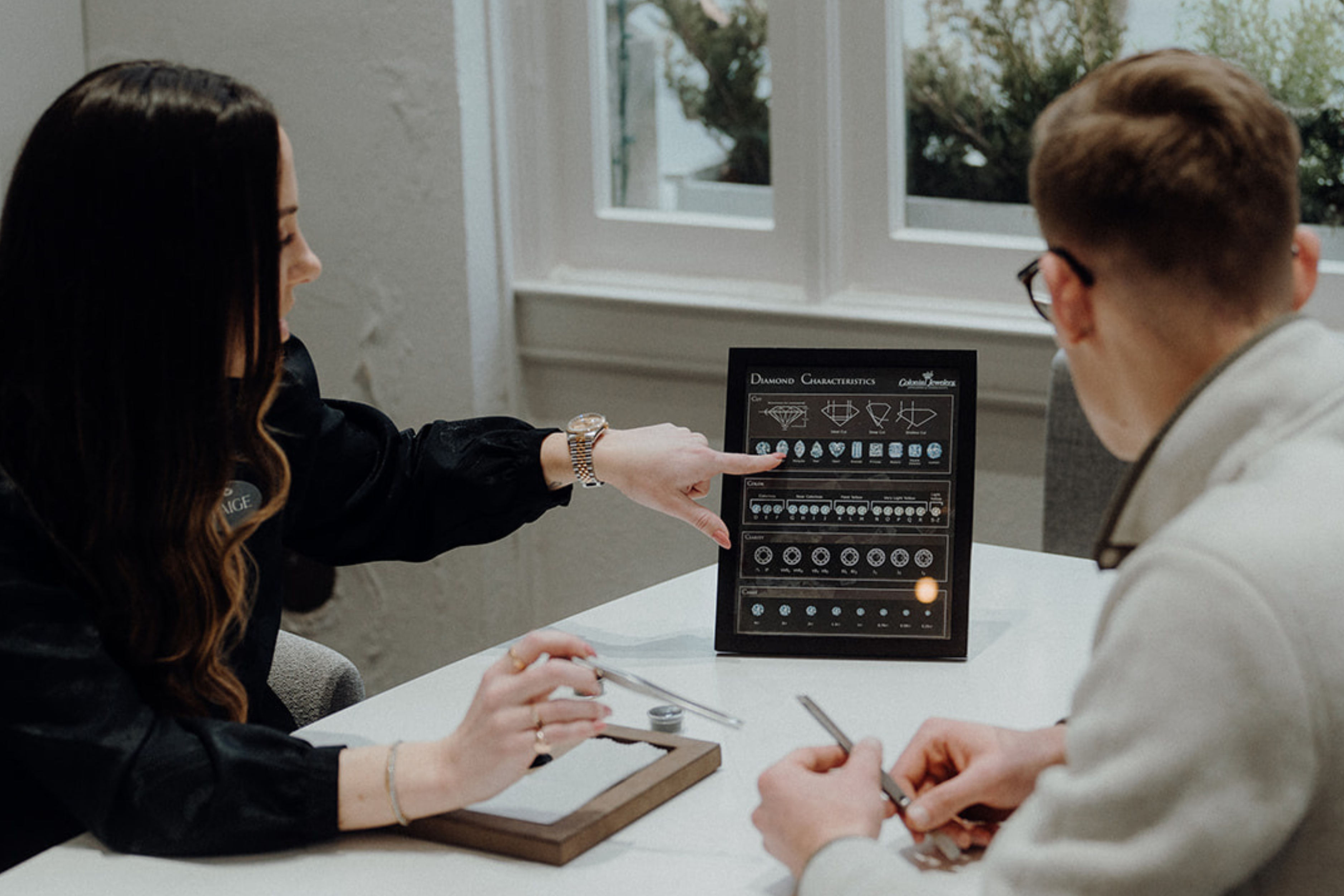The 4 C’s: Cut, Clarity, Color, Carat
1. CUT
Before shopping for a Diamond, you should familiarize yourself with the 4 C’s. Cut, Clarity, Color and Carat. Here at Colonial Jewelers we have a team of experts who will be happy to explain what all this means and how it will help you choose the best Diamond within your budget. In the meantime, let’s talk about Cut.
The cut is what fuels a diamonds fire, sparkle and brilliance. The appeal and beauty of a Diamond depends more on cut quality than anything else. The GIA Diamond Cut Grading System for standard round brilliants are in the D-Z color range is based on assessing seven components.
The first three are appearance based aspects,
- Brightness - the total light reflected from the Diamond
- Fire - the dispersion of light into the colors of the spectrum
- Scintillation - the pattern of light and dark areas and the flashes of light, or sparkle when a Diamond is moved Some would argue that this is not the place to try and save money when looking to purchase a Diamond.
The last four are related to the Diamonds design and craftsmanship,
- Weight ratio
- Durability
- Polish
- Symmetry
In GIA’s system, each of these factors are assessed individually. Each cut grade, based on a relative scale from Excellent to Poor, represents a range of proportion sets and face up appearance. Attractive Diamonds are produced by many different proportion sets.
2. CLARITY
At Colonial Jewelers we want to help you make the most informed decision when purchasing a Diamond. Whether you’re shopping for engagement rings, a tennis bracelet or looking to upgrade, you should be familiar with the 4 C’s. We’ve already talked Cut, now lets talk about Clarity.
Diamonds form deep within the earth, under an incredible amount of heat and pressure, because of this, they often contain unique birthmarks, either internal (inclusions) or external (blemishes). Diamond clarity refers to the absence of inclusions and blemishes. Diamonds found without these birthmarks are hard to come by which ultimately affects a Diamonds value. Using the GIA International Diamond Grading System all Diamonds are assigned a grade. Clarity grade ranges from flawless (FL) to Diamonds with noticeable inclusions (I3).
The GIA Clarity Scale contains 11 grades,
1. Flawless (FL) - No inclusions or blemishes
2. Internally Flawless (IF) - No inclusions, only blemishes
3. Very, Very Slightly Included (VVS1, VVS2) - Inclusions are difficult to see
4. Very Slightly Included (VS1 AND VS2) - Inclusions are minor and somewhat difficult to see
5. Slightly Included (SI) - Inclusions are noticeable
6. Included (I1, I2, I3) - Inclusions are obvious
(**based on a skilled grader using a 10x magnification)
3. COLOR
The color of a Diamond is all about what you can’t see. The value of a Diamond is determined by how close to colorless they are - the less color, the higher the value. The only exception to this is fancy color Diamonds, such as pinks and blues. These colors lie outside of this color range. GIA (Gemological Institute of America) set the industry standard color grading scale for Diamonds which goes from D (colorless), with increasing presence of color to the letter Z (light yellow or brown color). Each letter grade has a defined range of color appearance. Using controlled lighting and precise viewing conditions, Diamonds are color-graded by comparing them to stones of known color. To the untrained eye, the color variations are too subtle to notice however, when shopping for a Diamond you should know these slight differences help to determine quality and and price.
4. CARAT
Diamonds and other gemstones are weighed in metric carats, not to be confused with karat which refers to gold purity. One carat is equal to 0.2 grams, just about the same weight as a paperclip. A carat is divided into 100 points, a 50 point Diamond weighs 0.50 carats. Being precise is crucial because even a fraction of a carat can make a big difference in cost. Diamonds of equal weight can have totally different values depending on the other three C’s, clarity, cut and color.
